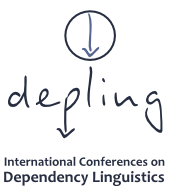

The dependency approach to language
Basics
Dependency grammars include all approaches to grammar that consider dependencies, i.e. labeled head-daugther relations between words, as their primary syntactic representations. This implies that dependency grammars do not refer to a particular framework, but rather that the notion of dependency can be explicit or implicit in the formalization of syntactic rules. Dependency can be opposed to a phrased structure based description of language, which puts constituent structures at its center. Yet, an X-bar type labelled constituent structure implicitly describes head-daughter relations between words, and, conversely, the projections of dependency subtrees can be seen as constituents. Moreover, most post-generative formalisms like LFG, TAG, and HPSG give a prominent place to dependency relations.
History
The history of contemporary theories on dependency is usually traced back to Tesnière and Peškovskij’s work in the 1930s, continuing its path, to cite a few, in the works of Hays (1960), Gaifman (1965), Robinson (1970), the Meaning-Text Theory around Mel'čuk (1988) in Moscow and Montreal, the new Prague school around Sgall, Hajičová, and Panevova (Sgall et al. 1986), the German dependency grammars (e.g. Engel 1992), and, in the English speaking world, in the work around Anderson (1971), Hudson’s Word Grammar (1984), and on Link Grammar (Sleator and Temperley 1991).
Current events
The return of dependency grammars to the forefront of debate may be explained by parallel and independent developments in theoretical and computational linguistics including:
- the growing interest in the lexical subcategorization frames of words, which naturally leads to functional descriptions of grammar;
- the new possibilities to extract rich lexical information from corpora, whose inclusion in formal grammars necessitates new forms of syntax;
- the need for formal and computational descriptions of meaning beyond simple predicate logic, which leads to semantic graphs, having features similar to dependency trees;
- the increasing research on a wider range of languages, including languages with “free” word order, where the distinction between constituency and dependency shows up clearly.
